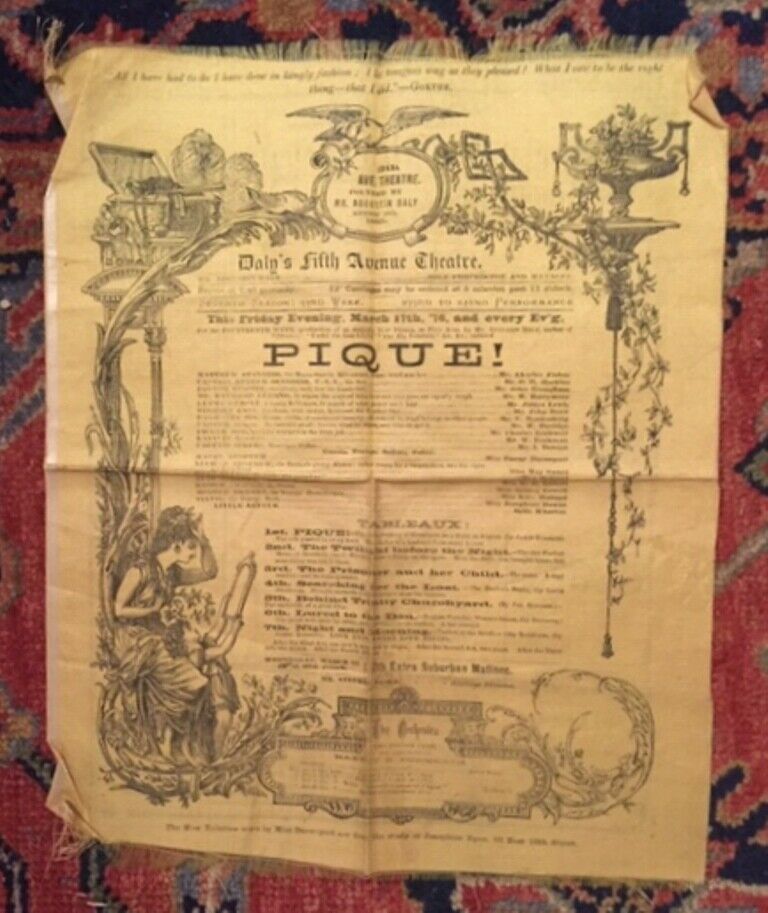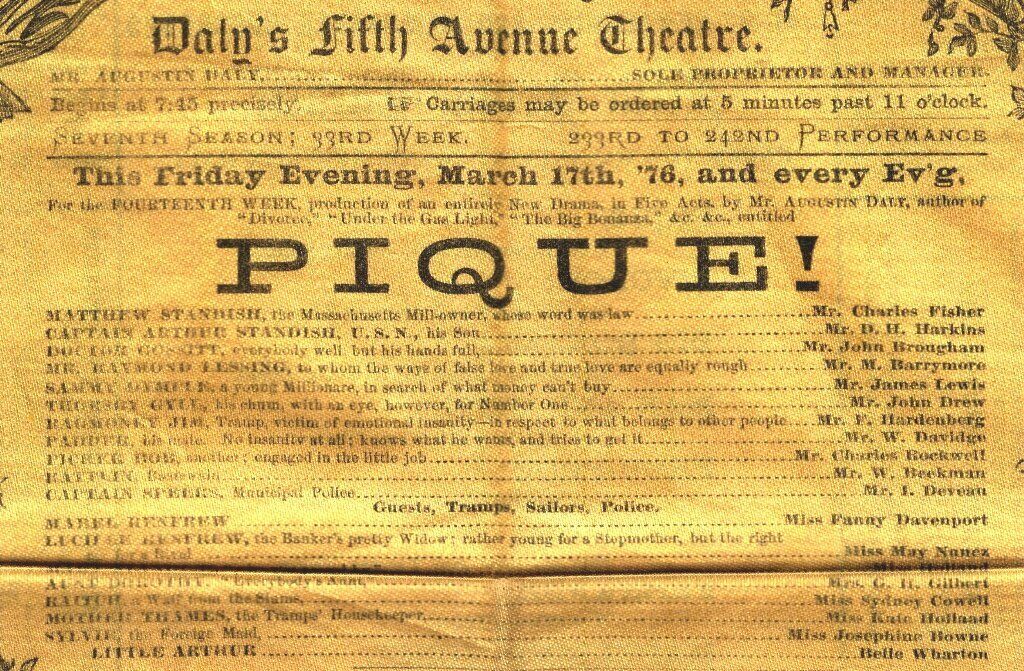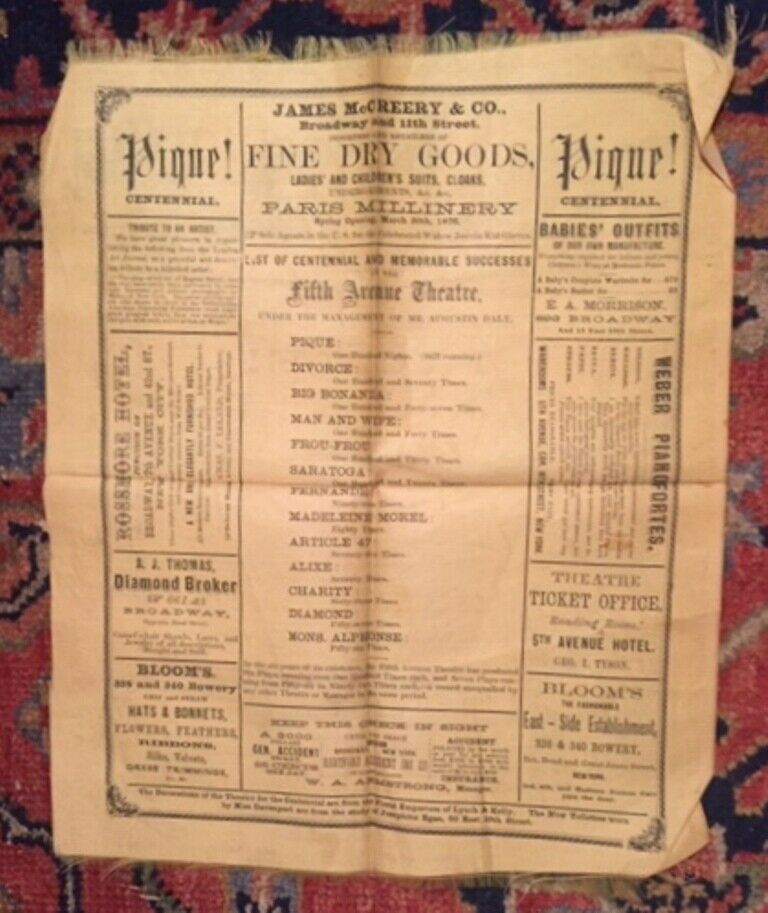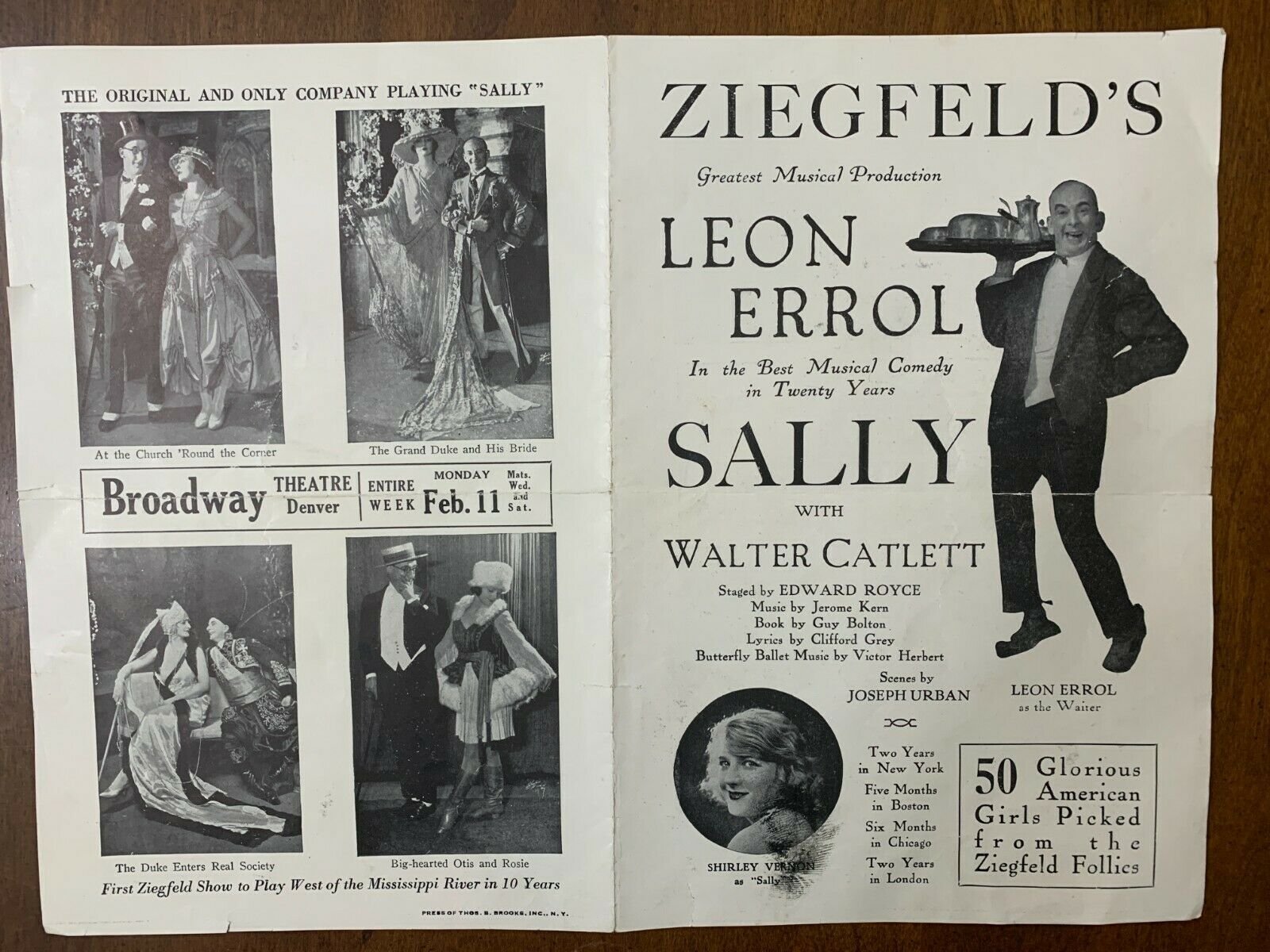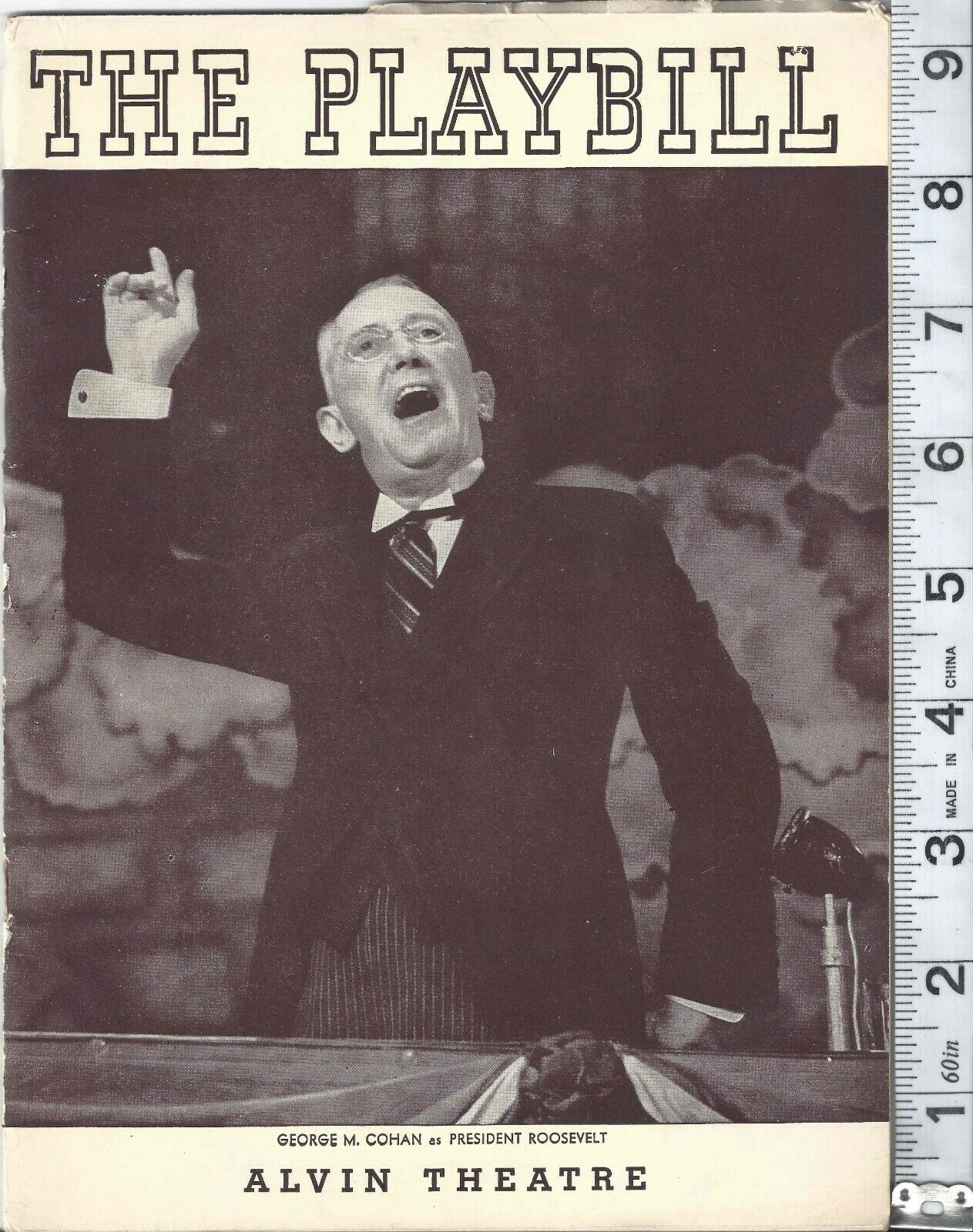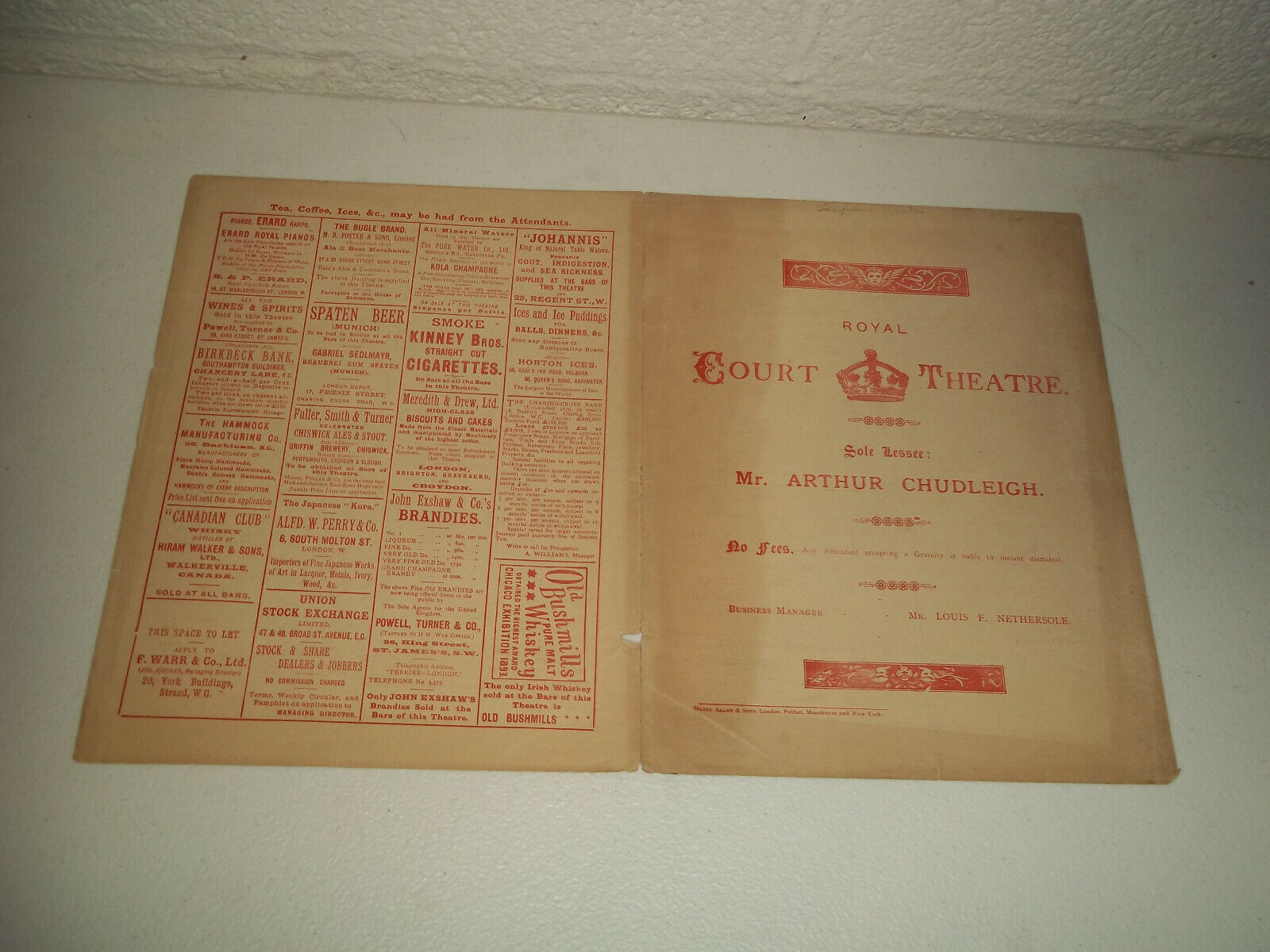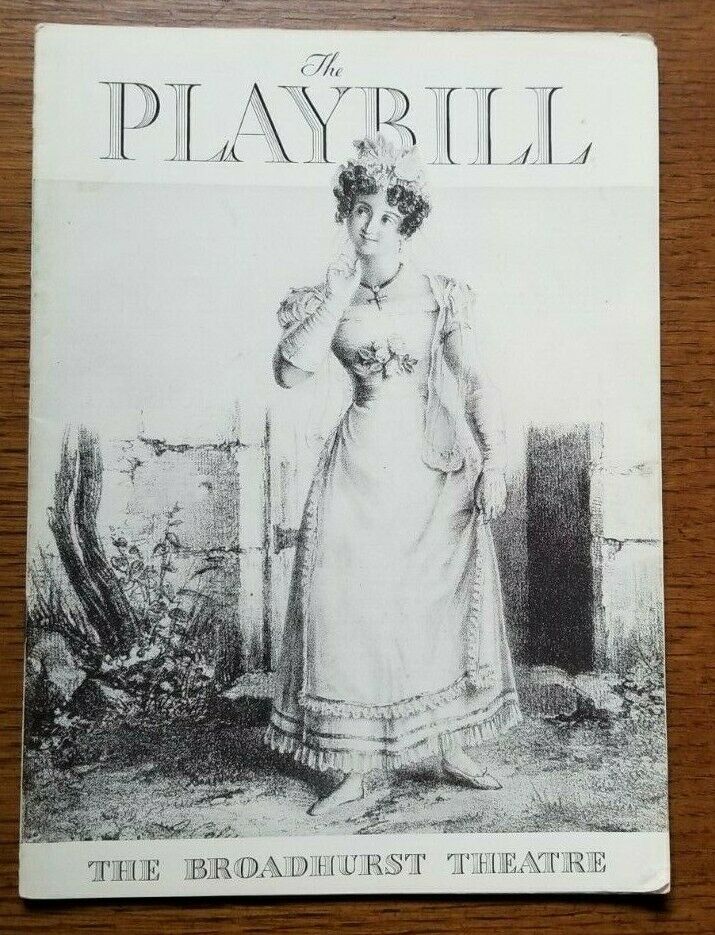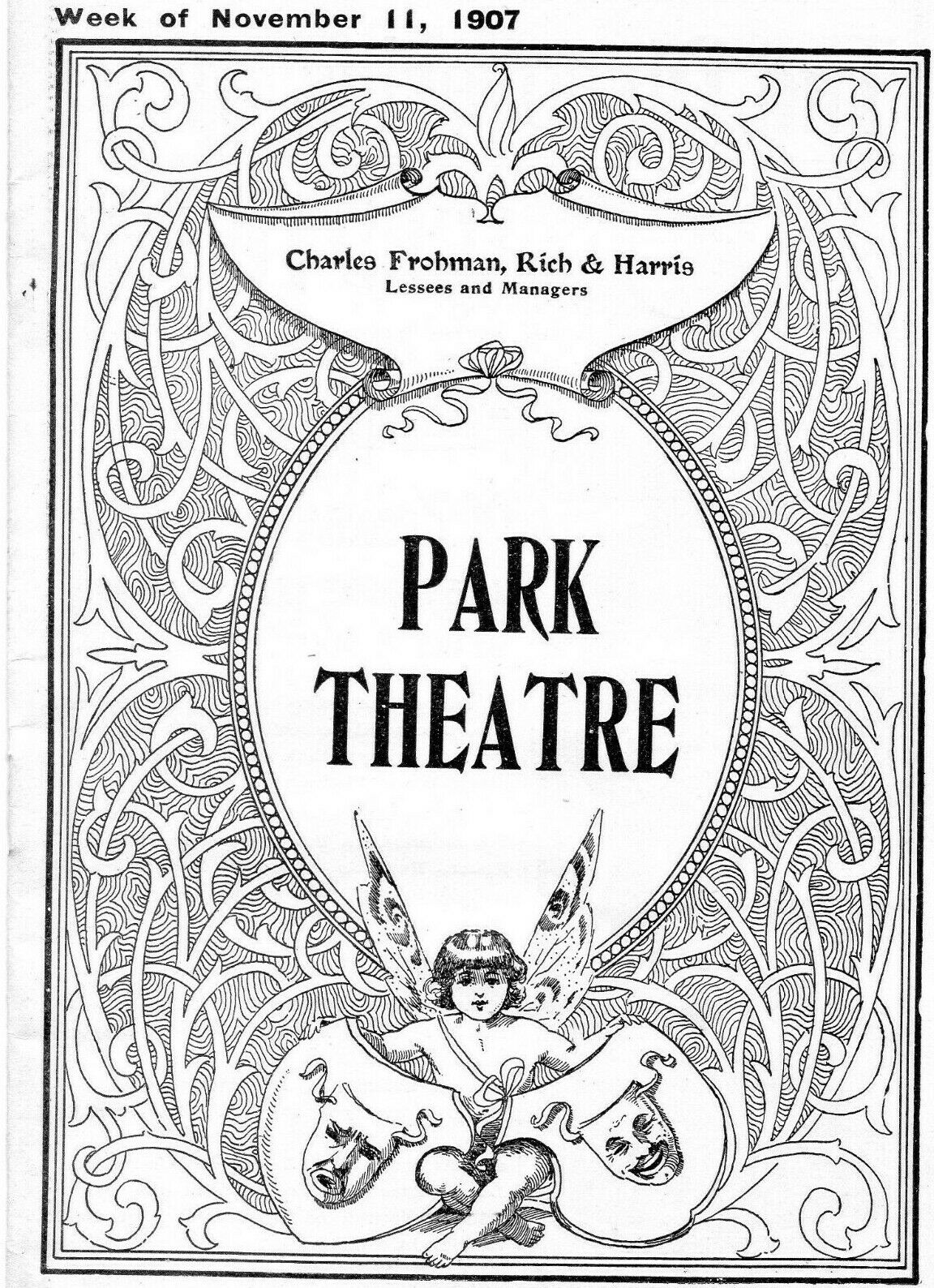-40%
*MAURICE BARRYMORE JOHN DREW 1876 GOLD SILK SOUVENIR PROGRAM AUGUSTIN DALY*
$ 95.03
- Description
- Size Guide
Description
An extraordinary original 1876 gold silk souvenir program for Augustin Daly's production of Pique with Maurice Barrymore and John Drew. Dimensions eleven and a half by nine and a half inches. Fine baby soft silk printed on both sides. Light wear and light folds otherwise good. See Maurice Barrymore, John Drew, and Augustin Daly's extraordinary biographies below.Shipping discounts for multiple purchases. Inquiries always welcome. Please visit my other eBay items for more early theatre, opera, film, magic, and historical autographs, photographs, programs and broadsides and great actor and actress cabinet photos and CDV's.
From Wikipedia:
Herbert Arthur Chamberlayne Blythe
(21 September 1849
[1]
– 25 March 1905), known professionally by his stage name
Maurice Barrymore
, was an Indian-born British stage actor. He was the
patriarch
of the
Barrymore acting family
, father of
John
,
Lionel
and
Ethel
, and great-grandfather of actress
Drew
.
Born Herbert Arthur Chamberlayne Blythe in
Amritsar
,
India
, he was the son of William Edward Blythe (1818–1873), a surveyor for the
British East India Company
, and his wife Charlotte Matilda Chamberlayne de Tankerville (1822–1849) who had some French descent. Herbert, the youngest of seven, had an older brother named Will and two sisters named Emily and Evelin. Three other siblings had died in infancy.
[3]
Matilda, after a difficult pregnancy, died shortly after giving birth to Herbert on 21 September 1849. In his formative years Herbert was raised by his Aunt Amelia Blythe, his mother's sister, and later by other family members. Amelia, a Chamberlayne by birth, had married a brother of Herbert's father and was a Blythe by marriage.
Herbert was sent back to England for education at
Harrow School
, and studied Law at
Oxford University
, where he was captain of his class
football
team in 1868. Herbert also became enamored of the sport of
boxing
. The
Marquess of Queensberry Rules
were firmly established at this time but it wasn't unusual to see
bare knuckle
fights. On 21 March 1872 Herbert won the
middleweight
boxing championship of
England
. Years later many of Herbert's friends would be sports figures of the day, particularly boxers and wrestlers such as
William Muldoon
,
John L. Sullivan
,
James J. Corbett
and a young actor named
Hobart Bosworth
, the latter of whom Herbert would stage in an amateur bout with his son Lionel.
[1]
Herbert's father expected him to become a
barrister
, but Herbert fell in with a group of actors, which scandalized the elder Blythe. That same year 1872 Herbert sat for his first posed theatrical photographic portrait by Oliver Sarony, older brother of the better remembered
Napoleon Sarony
. In order to spare his father the "shame" of having a son in such a "dissolute" vocation, he took the stage name Maurice Barrymore (though he never legally changed from "Blythe"), inspired by a conversation he had with fellow actor Charles Vandenhoff about William Barrymore (1759–1830),
[4]
an early 19th-century English thespian, after seeing a poster depicting Barrymore in the
Haymarket Theatre
. He wanted his first name to be pronounced in the French manner (môr-ĒS) instead of the English (MÔR-is). His friends avoided that altogether by simply calling him "Barry".
[5]
Career and marriage to Georgiana Drew
Maurice Barrymore as Wilding in
Captain Swift
(1888) by C. Haddon Chambers
[6]
Maurice Barrymore mid 1890s.
On 29 December 1874, Barrymore emigrated to the United States, sailing aboard the SS
America
to
Boston
, and joined
Augustin Daly
's troupe, making his début in
Under the Gaslight
. He made his
Broadway
début in December 1875 in
Pique
opposite
Emily Rigl
; in the cast was a young actress,
Georgiana Drew
, known as Georgie. Maurice and Georgiana had been introduced earlier by her brother
John Drew Jr.
who had befriended Maurice when he first arrived in America. Drew Jr. and Georgiana later brought Barrymore home to Philadelphia to be introduced to her mother, the formidable Mrs. John Drew, who for some reason wasn't too enthralled by the young man.
After a brief courtship, Barrymore and Georgie married on 31 December 1876, and had three children:
Lionel
(born 1878),
Ethel
(born 1879), and
John
(born 1882). While their parents were on tour, the children lived with Georgiana's mother in Philadelphia. Barrymore had a lifelong love of animals and in the 1890s bought a farm on Staten Island to keep his collection of exotic animals. Georgiana died 2 July 1893, from
consumption
leaving Maurice a widower with three teenage children. For a summer in 1896, Lionel and John were left on the farm in the care of the man who fed the animals. Exactly one year after Georgie's death Barrymore married Mamie Floyd, much to Ethel's consternation.
Shooting
On 19 March 1879, in
Marshall
, Texas, Barrymore and fellow actor Ben Porter were shot by a notorious
gunfighter
and bully named Jim Currie.
[7]
[8]
Barrymore and Porter had played cards earlier with Currie, winning some money from him. That evening, while Barrymore, Porter and the actress Ellen Cummins dined at the White House Saloon, an intoxicated Currie began insulting and goading them into a fight. Barrymore challenged Currie to a fistfight. Currie shot him in the chest and then shot Porter in the stomach. John Drew, Jr., also with the company, showed up at the doorway after being alerted by all the commotion but Currie didn't shoot him. Porter was killed, while doctors spent the night operating on Barrymore to save his life. Georgie, then several months pregnant with Ethel, rushed to Texas to be at her husband's side enduring a long train trip. He made a full recovery, and returned to Marshall for the legal procedures that followed. Currie's brother was Andrew Currie, mayor of
Shreveport
, Louisiana, from 1878 to 1890 and later a member of the Louisiana state legislature,
[9]
who apparently used his influence to secure a not guilty verdict (after a 10-minute deliberation).
[8]
An enraged Barrymore vowed never to return to Texas.
According to a 2004
A&E
Biography
piece, after the Ben Porter tragedy, Barrymore asked Georgiana to tour with him and
Helena Modjeska
in a play he had written. Georgiana and the children had converted to
Roman Catholicism
under Helena's influence. Learning that he and Helena had resumed their romance, Georgiana, who had been given ownership of the play by Barrymore, forced his hand by closing it. Helena's husband, its producer,
sued
her. The real reason for Georgiana's actions never got into the press. However, Barrymore's many dalliances did make the newspapers.
Nadjezda
In 1884, Barrymore wrote a play titled
Nadjezda
(meaning "hope").
[10]
During this period he sailed with his wife Georgiana and their children Lionel, Ethel and John, then respectively 6, 5 and 2, to England to visit relatives he hadn't seen since migrating to America. (He had inherited some money from his aunt Amelia, one of his family members who helped raise him.) During the trip Barrymore met the great French actress and star
Sarah Bernhardt
. Without copyrighting his play, he gave her a copy of the manuscript. In 1886,
Victorien Sardou
, a friend of Bernhardt's, wrote his play
La Tosca
,
which later achieved great fame as an opera. Barrymore claimed that Bernhardt had given his play to Sardou and that
La Tosca
plagiarized it, and sought an injunction to stop
Fanny Davenport
from putting on further performances. In affidavits read out in court Bernhardt said that she had never seen the play and knew nothing about it, and Sardou said that preliminary material for the play had been in his desk for fifteen years. In fact, the only resemblance to
La Tosca
is the unholy bargain the heroine makes to save her husband's life, similar to that of Tosca and Baron Scarpia. As Sardou pointed out in his affidavit, this plot device is a common one and had been notably used by Shakespeare in
Measure for Measure
.
Last years
Lithograph of Barrymore with
Mrs. Leslie Carter
in
The Heart of Maryland
, 1895
In 1896, Barrymore became the first major Broadway star to headline in
Vaudeville
—a brave foray at the time. During his career, Maurice Barrymore played opposite many of the reigning female stars of the time including
Helena Modjeska
,
Mrs. Fiske
,
Mrs. Leslie Carter
,
Olga Nethersole
,
Lillian Russell
, and
Lily Langtry
. In the 1895 theater season on Broadway he co-starred with Mrs. Leslie Carter in
The Heart of Maryland
. In the 1899 season on Broadway he had a success playing opposite Mrs. Fiske in the part of Rawdon Crawley in
Becky Sharp
.
[11]
This play was based on a character from
William Thackeray
's novel
Vanity Fair
.
Becky Sharp
was Barrymore's last Broadway success. In 1900, Barrymore toured the U.S. with a play called
The Battle of the Strong
co-starring a young
Holbrook Blinn
. In the company of this play was a five-year-old child actress,
Blanche Sweet
, who grew up to be a silent movie actress and acted with Lionel in his first Biograph film. When the
Battle of the Strong
company stopped in
Louisville, Kentucky
Barrymore sat for his last posed photograph. Also during this time he got to spend time with his son John, who was now in his late teens. Lionel and Ethel were on the road in theater companies, having already started their careers.
Mental breakdown and death
On 28 March 1901, Barrymore was performing at the Lion Palace Theatre in New York when he suddenly departed from his monologue and shocked the audience with what was described as "a blasphemous attack on the Jews" and a rant of "such an emotional pitch that tears rolled down his face." After further erratic behavior, Barrymore was committed to Bellevue Hospital by a court order obtained by his son.
[12]
In reporting his death on 25 March 1905,
The New York Times
recalled that "He was playing a
vaudeville
engagement [in 1901] at a
Harlem
theatre when he suddenly dropped his lines and began to rave." The following day he became violent and was taken to
Bellevue
insane ward by his son, John, who lured him under the pretense of starring in a new play. At Bellevue and later
Amityville
he was diagnosed with the lingering effects of
syphilis
, an incurable disease at the time. During his stay at Bellevue he almost strangled his daughter Ethel during a visit. Ethel, through her early success on the stage, would pay for her father's stay in the institutions. A trained boxer, Barrymore's strength remained, as in a scuffle with one of the Bellevue attendants, he picked the man up over his head and threw him into a corner.
In 1905 Barrymore's son Lionel visited him at Amityville and the subject of San Francisco came up. Maurice called Lionel a "goddamned liar" and stated that San Francisco had been destroyed by fire and earthquake. Lionel writes in his autobiography that his father had foreseen the
great 1906 earthquake
a full year before it took place.
[13]
Barrymore died at Amityville in his sleep, and Ethel had him buried at Glenwood Cemetery in
Philadelphia
.
[2]
When the cemetery was later closed his remains were moved to
Mount Vernon Cemetery
, also in Philadelphia, where his first wife and her family are buried. Barrymore was fondly remembered and his death was widely reported in the country's newspapers. He had lived long enough to see all three of his children grow up and enter the family business of
acting
.
[14]
In memoriam
In honor of his life, Michael J. Farrand penned the memorial narrative poem "The Man Who Brought Royalty to America" in 2000, based on the definitive biography
Great Times, Good Times: The Odyssey of Maurice Barrymore
by James Kotsilibas Davis (Doubleday, 1977).
John Drew Jr.
(November 13, 1853 – July 9, 1927) was an
American
stage actor noted for his roles in
Shakespearean
comedy, society drama, and light comedies. He was the eldest son of
John Drew
, who had given up a blossoming career in whaling for acting,
[1]
and
Louisa Lane Drew
, and the brother of Louisa Drew,
Georgiana Drew
and
Sidney Drew
. As such, he was also the uncle of
John
,
Ethel
, and
Lionel Barrymore
and also great-great uncle to
Drew Barrymore
. He was considered to be the leading
matinee idol
of his day, but unlike most matinee idols Drew's acting ability was largely undisputed.
John Drew Jr. was educated at a fine academy in Philadelphia, but the life of the theater would become his primary focus at a young age.
[1]
His first role as a boy was "Plumper" in
Cool as a Cucumber
at the family's Arch Street Theater.
[2]
Drew had a long association with
Charles Frohman
and leading lady
Maude Adams
. In these years under Frohman, John Drew's stardom was established.
[3]
His first play with Frohman was
The Masked Ball
, a comedy adapted from a French play. This show was primarily a vehicle to establish Drew's stardom under Frohman, and it succeeded in that.
[3]
Drew was associated originally with the company of
Augustin Daly
in the 1880s, a man known for managing and training with grim efficiency.
[3]
Under Daly's management, John Drew developed his reputation for versatility, appearing in many varieties of play, but especially in contemporary works that are rarely performed or remembered today.
[2]
His frequent leading lady with Daly was
Ada Rehan
. His memoirs, titled
My Years on the Stage
, were published in 1922. His final Broadway play was
The Circle
co-starring fellow veteran star
Mrs. Leslie Carter
and proved to be a popular comeback for the two Victorian actors. The Circle was made into a
silent film
in 1925 by
MGM
directed by
Frank Borzage
.
Highly esteemed by his fellow actors, John Drew was elected lifetime president of New York City's
Players' Club
. The abbreviation "Jr.", distinguishing him from his long deceased actor father, is usually dropped. He died in San Francisco on July 9, 1927 shortly after having been visited by his nephews John and Lionel Barrymore both of whom had taken time off from movie making on the West Coast. After cremation his remains were taken to Philadelphia and interred at
Mount Vernon Cemetery
alongside his wife.
[4]
Drew and his wife Josephine (
nee Baker
)
[5]
had one daughter,
Louise Drew
(1882–1954). Louise married Broadway actor Jack Devereaux
[6]
and they had a son John Drew Devereaux.
John Augustin Daly
(July 20, 1838 – June 7, 1899) was one of the most influential men in American theatre during his lifetime. Drama critic, theatre manager, playwright, and adapter, he became the first recognized stage director in America. He exercised a fierce and tyrannical control over all aspects of his productions. His rules of conduct for actors and actresses imposed heavy fines for late appearances and forgotten lines and earned him the title "the autocrat of the stage."
[1]
He formed a permanent company in New York and opened Daly's Theatre in New York in 1879 and a second one in London in 1893.
[2]
Augustin Daly was born in
Plymouth, North Carolina
to Captain Denis Daly a sea-captain and ship owner, and Elizabeth, daughter of Lieutenant John Duffy of the British Army. He was educated at
Norfolk, Virginia
, and in the public schools of New York City. His mother, early left a widow, brought her two boys to New York City, where they soon became frequent attendants at the theaters and were members of amateur groups, which under such names as the "Burton Association" or the "Murdoch Association" were the precursors of the
Little Theatre Movement
.
[3]
He was dramatic critic for several New York papers from 1859, and he adapted or wrote a number of plays,
Under the Gaslight
(1867) being his first success. In 1869 he became the manager of the
Fifth Avenue Theatre on 24th St.
and in 1873 the
Fifth Avenue Theatre
on 28th. In 1879 he rebuilt and opened
Daly's Theatre
at Broadway and 30th Street in New York, and, in 1893,
Daly's Theatre
in London.
[4]
Reading The Play (1882)
At the first of these, he gathered a company of players, headed by
Ada Rehan
, which made for it a high reputation, and for them he adapted plays from foreign sources, and revived
Shakespearean
comedies in a manner before unknown in America. He took his entire company on tour, visiting England, Germany and France, and some of the best actors on the American stage have owed their training and first successes to him.
[4]
Among these were
Clara Morris
, Sara Jewett,
John Drew, Jr.
,
Maurice Barrymore
,
Fanny Davenport
,
Agnes Ethel
,
Maude Adams
,
Mrs. Gilbert
,
Tyrone Power, Sr.
,
Ada Dyas
,
Isadora Duncan
,
Maud Jeffries
and many others. Daly's willingness to, as he put it, "stoop to the curb and bestow upon the low, untried actor a chance at greatness" earned him the nickname "Little Man Auggie" among his peers. His play
Leah the Forsaken
, adapted from
Hermann Salomon Mosenthal
's
Deborah
, was a star vehicle for
Margaret Mather
.
His Shakespeare productions were often severely criticized by
George Bernard Shaw
, who was active as a drama critic during those years. Shaw took Daly severely to task for cutting Shakespeare's plays and for presenting them in unorthodox ways. (Shaw was a strong believer in presenting Shakespeare's plays uncut.) Several of Shaw's criticisms of Daly's Shakespeare productions were reprinted in the anthology
Shaw on Shakespeare
.
[5]
Daly was a great book-lover, and his valuable library was dispersed by auction after his death, which occurred in
Paris
. Besides plays, original and adapted, he wrote
Woffington
: a Tribute to the Actress and the Woman
(1888).
[4]
Dora Knowlton Ranous
, a onetime actress in the Daly company, published a 1910 memoir of her experiences entitled
Diary of a Daly Débutante.
[6]
Notable works
Poster from the
Royal Lyceum
,1886
Under the Gaslight
(1867) is an example of Daly's mixture of realism and melodrama, seen in the authenticity of his depiction of real locations and in his use of social commentary.
[7]
The play introduced the now-clichéd device of the villain tying someone to railroad tracks, although in a reversal of the usual roles it was the hero who was tied up and the heroine who saved him.
[8]
In the book
Vagrant Memories,
the author,
William Winter
recalls how Daly came up with the device. He says: "He once told me under what circumstances he hit upon this device. He was walking home toward night, thinking intently about the play which he had begun to write, when suddenly the crowning expedient occurred to him and at the same instant he stumbled over a misplaced flagstone, striking his right foot against the edge of the stone and sustaining a severe hurt. "I was near my door," he said, "and I rushed into the house, threw myself into a chair, grasping my injured foot with both hands, for the pain was great, and exclaiming, over and over again, 'I've got it! I've got it! And it beats hot-irons all to pieces!" I wasn't even thinking of the hurt. I had the thought of having my hero tied on a railroad track and rescued by his sweetheart, just in the nick of time, before the swift passage of an express train across a dark stage.
[9]
A Flash of Lightning
(1868), like
Under the Gaslight
, is pure melodrama, with water and fire spectacles providing action scenes and special effects for its eager audiences.
[7]
Horizon
(1871) is an adaptation of a
Bret Harte
story about the westward expansion of the States; it is an example of the popularity of western drama, coupled with Daly's interest in realism of the
local color
variety, although it remains melodramatic.
[7]
Divorce
(1871) and
Pique
(1875), both adaptations of British novels, demonstrate Daly's attempts to create social comedy, although the plays remain somewhat melodramatic.
[
